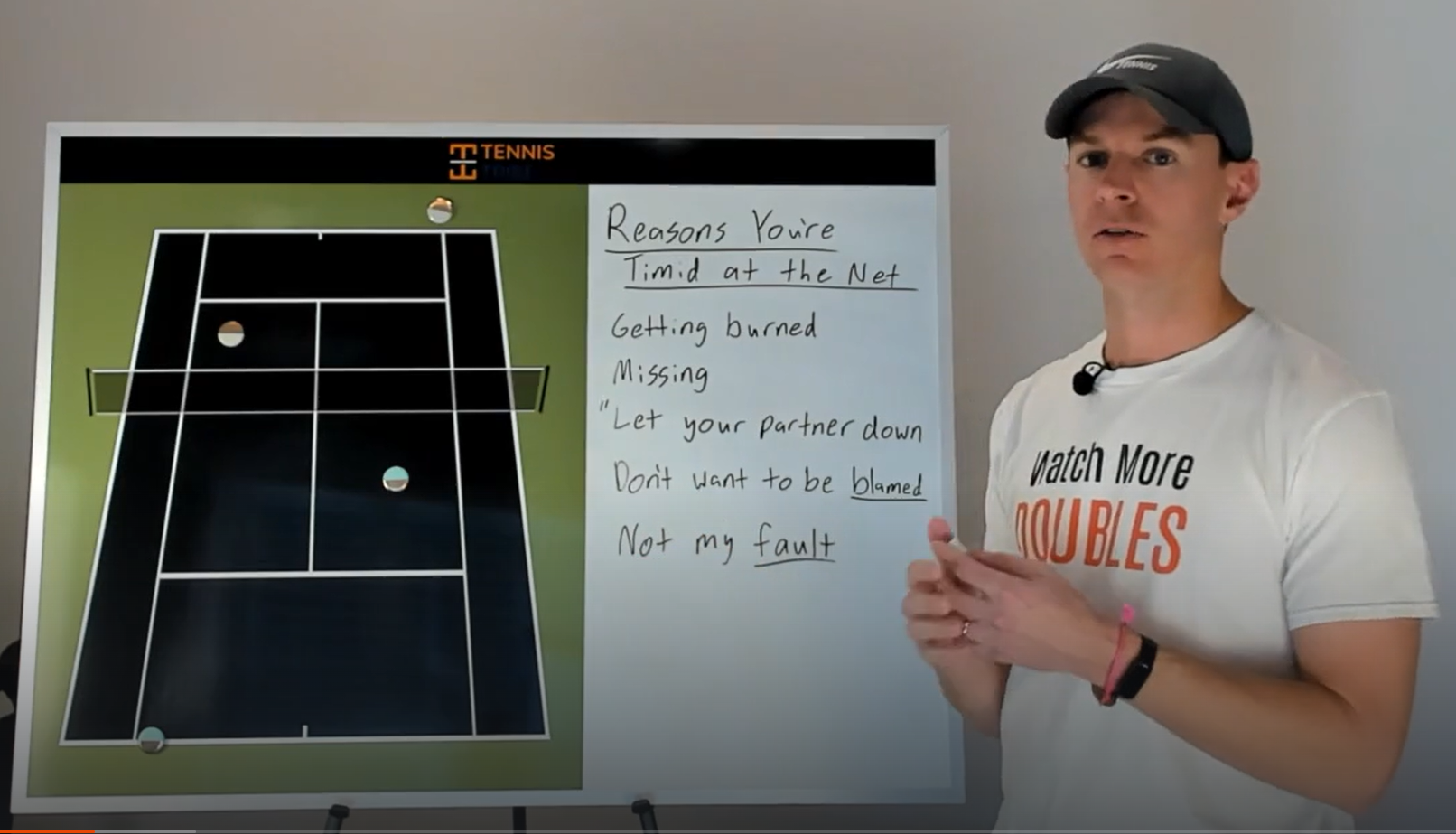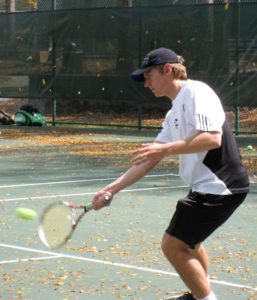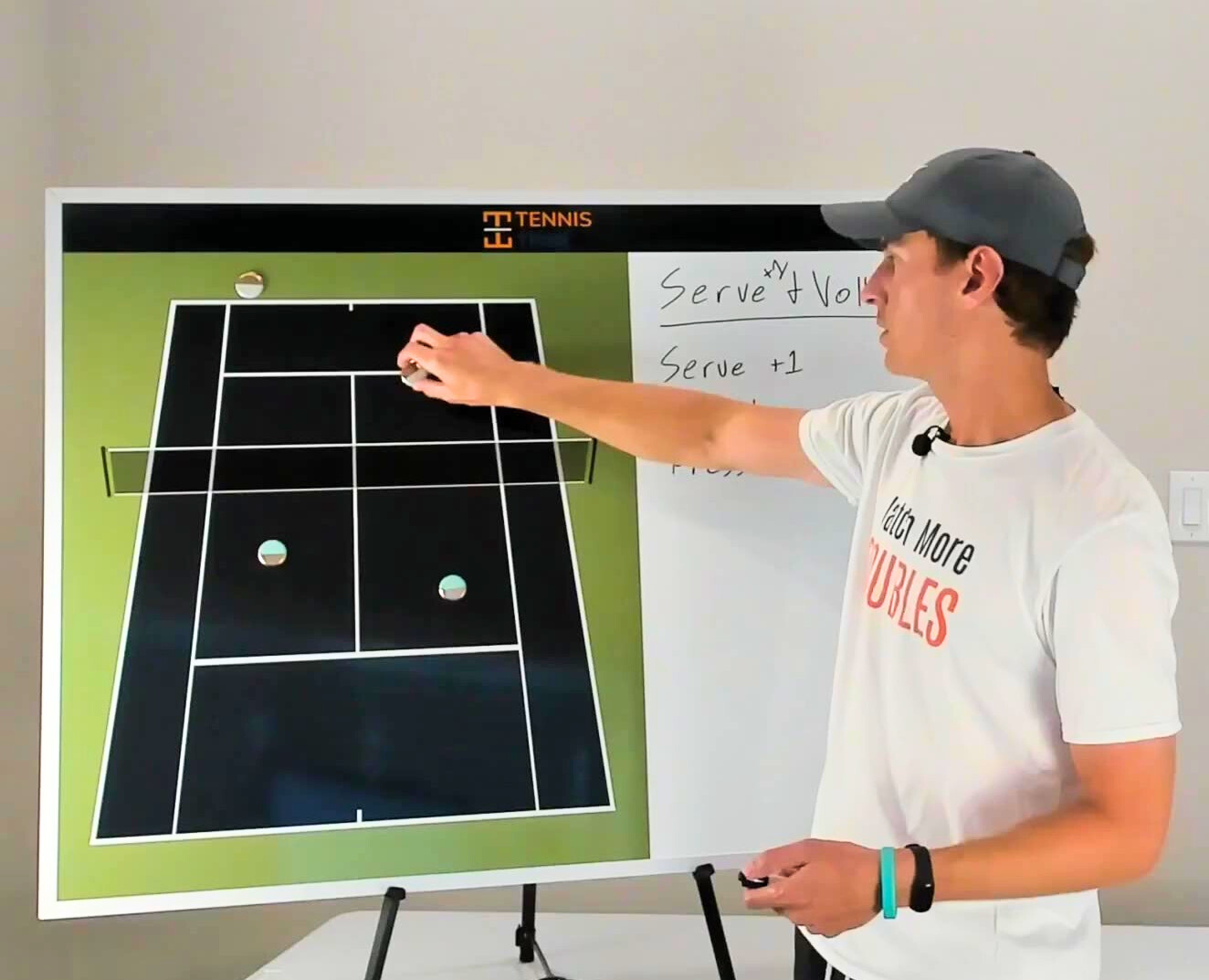Do you ever feel like you’re missing too many volleys? Maybe you don’t have the confidence you need to go to the net and volley to end the point?
Today, you’re going to learn exactly how to volley in tennis.
I’m going to show you the right grip for your volleys, proper volley technique, and a checklist with tips that I personally use on the court to fix my own missed volleys. Finally, I’ll show you volley drills you can use to improve your confidence in your ability to volley.
Follow this guide to start hitting clean volleys and actually win points from the net instead of missing volleys in the net or floating them for the other team.
The Right Grip for a Tennis Volley
The first step to hitting a good volley in tennis is getting the right grip. Without the right volley grip, you won’t be able to hit clean volleys or be an effective net player in doubles or singles.
Good tennis coaches teach the continental forehand grip for both the forehand and backhand volley. That’s what pro tennis players use as well.
When you’re at the net you need to be able to react quickly, so having the same grip for both volleys is important. You typically don’t have time to change grips between forehand and backhand volleys.
If you have a swinging volley you can use your forehand and backhand groundstrokes grip, but usually, after that shot, you will want to change to the continental grip for the next shot. Swinging volleys are typically used to end the point or to transition from the baseline to the net.
COURSE
Net Play Strategy for Doubles
Masterclass on skills, strategy, and mindset for dominant net play in doubles!
- Over 190 minutes of Video Doubles Lessons
- 25 Whiteboard Video Lessons
- Video Analysis of over 30 ATP & WTA doubles points

You’ll learn from Will Boucek, an ATP & WTA Doubles Strategy Analyst
3 Keys to Good Volley Technique
After you have the right grip, you must have proper volley technique to become a good net player.
Here is an easy three-point checklist to make sure you’re using good volley technique. Write these down on a notecard and put them in your tennis bag. Remind yourself to do these 3 things and you’ll start hitting better volleys, guaranteed.
#1 Volley Footwork – Get in the Right Position
The first step to good volley technique is using your footwork to get into good position.
A lot of people use a split step to get under control before preparing for the volley. This is optional but probably a good idea for beginners or players who are approaching the net quickly.
Once you know if you’re hitting a forehand or backhand volley, you need to turn sideways at about a 45-degree angle from the net, with your hips slightly closed. Your feet should be staggered at the same 45-degree angle.
For right-handed players, you’ll have your left foot forward for forehand volleys and right foot forward for backhand volleys.
#2 Your Racquet Positioning
Many players start with their racquet too high, or too far back on their volleys.
To hit clean volleys, your racquet needs to be behind the place where you will make contact with the ball, without bringing the racquet behind your body.
If you bring the racquet back too high, then you will have to chop down on your volleys which causes the ball to pop up and float (this is a common mistake for beginners and advanced players). Bringing the racquet too far back, behind you can leave room for error in your volley technique and makes the shot more difficult to time.
Your hand should be slightly under the racquet head and strings tilted slightly up depending on how low the volley is. The lower volleys will require the strings to be pointed higher to get the ball over the net, and your racquet head will drop.
You can think of the volley as a punch, you don’t swing as you do with groundstrokes because you’re already close to the net. You’re also hitting the ball before it bounces, so you use the momentum of the ball to get your power. You usually need to have a firm grip and wrist as well.

You’ll absorb some impact on the volley depending on which type of volley you want to hit. For a drop shot, your wrist will give more on contact, but for a more powerful volley, you will want a firm wrist.
MOST POPULAR COURSE!
25 Winning Doubles Tactics
Guaranteed to help you play smarter & win more matches.
- Over 50 video doubles lessons
- 60+ ATP & WTA points analyzed
- Nearly 3 hours of strategy content

Will Boucek – ATP & WTA Doubles Strategy Analyst.
#3 Keep Your Momentum Forward
Make sure you’re moving forward, NOT sideways or backward when hitting the volley.
This is the most important tip on the list. Your body weight and feet should be leaning and moving forward into the shot. As you hit the volley you should transition your weight from your back to front foot while opening your hips from the closed position to let your arms release the energy through the racquet into the ball.
A lot of people are scared to close into the net and keep their momentum forward because they might get hit. Actually, if you’re on your heels, then you’re MUCH more likely to get hit.
You can do an exercise where someone tosses a ball at you while you’re on your heels, then again while you’re on the balls of your feet leaning forward. It’s easier to dodge the ball when you’re on the balls of your feet.
The Forehand Volley
Most tennis players prefer their forehand volley. It is easier because you have more reach to poach, and can control the racquet better on that side.
For a good forehand volley, follow the technique described above. You’ll also want to keep your left hand up and extended from your body. As you hit the forehand volley you’ll bring it into your body so both arms are coming together. This will help you keep your balance and control.
To change the direction of the ball, you simply adjust your wrist and racquet position slightly. To hit the volley crosscourt (left for right-handed players), you’ll have the racquet head in front of your wrist. To hit a down the line forehand volley, or to the right, you’ll close your stance a little more and open your wrist slightly to bring the head of the racquet back a little more.
Small changes in racquet position result in big directional changes for the volley.
The Backhand Volley
The backhand volley is usually the weakest volley for tennis players.
Volleys are not taught as much as groundstrokes in tennis, and the backhand volley is the primary victim of this.
To hit a good backhand volley you’ll need to close your hips and feet early, then time the volley right. Once you close your hips and have the racquet slightly behind you, you’ll open your hips to drive your racquet head forward through the ball.
The most common mistake players make with the backhand volley is starting with their racquet too high. This causes them to chop down on the volley and the ball pops up and lacks any pace. Because of this tendency, I like to start with my racquet lower than I think it should be, then lift the racquet head as I swing if needed.
Watch Roger Federer hit backhand volleys in slow motion for 1-2 minutes.
He starts with the racquet high but drops it before impact to get the racquet head through the ball. The strings are pointed in the direction he wants the ball to go.
3 Simple Volley Tips: The Checklist
There’s a lot to remember when you’re hitting volleys at the net. So I broke it down into a short volley tips checklist, that covers everything you’ll need.
I’ve watched hundreds of hours of both professional and USTA tennis, and these volley tips correct the most common mistakes I see.
Once you start using this volley checklist, I guarantee you’ll start making more volleys and feeling more confident to be at the net.
Tip #1: Move Forward on Your Volleys
Without moving forward you’re leaving it up to your arm to do all the work, then you may get into a habit of swinging on your volleys which will increase room for error and decrease your percentage. This is a bad habit that many tennis players make.
Instead, have your body’s momentum going forward and keep the motion with your arm small. This leaves less room for error and makes volleys easier. Your forward body momentum and a firm wrist and grip will drive the ball through the court.
Be sure to focus on your volley footwork as you do this. A lot of people lung at the volley and get off balance when they try to move forward. I do this sometimes when my legs are tired and I’m poaching. The result is usually a missed volley in the net 🙁
Instead, shorten your steps and stay under control.
I see people all the time miss a volley and grab their racquet and replay the volley as if it’s something their arm or upper body hit the ball wrong. That’s almost never the case. Your upper body didn’t “forget” how to hit a volley.
It’s almost always the footwork, positioning, and momentum that determines the result of the volley.
Tip #2: Stand Closer to the Net & Don’t Let the Ball Drop
The closer you are to the net, the easier the volley will be.
It’s much easier to clear the net, and drive the ball down into the court, or towards your opponent’s feet if you’re closer to the net.
Standing further back also allows the ball to drop to your feet, making a much more difficult volley. Too many people back up and let the ball bounce or drop below their waist before hitting it. Instead, try moving forward and hitting the ball at the highest point that you can.

Close fast and under control. A volley hit from shoulder height is much easier than a volley hit from your knees.
If you can, always be at least halfway between the service line and net on your volleys.
Don’t hit volleys from the service line unless you’re hitting a half volley to move forward to the net.
Tip #3: Move Your Racquet Through the Path of the Ball
If your volleys pop up or float more than you’d like, you’re probably carving your racquet under the ball instead of hitting through it. Your racquet’s path on the volley needs to be towards the place you want to hit it, not down.
To fix this, tilt your strings a little more towards the direction you want to hit the ball, instead of towards the sky.
Also, start with your racquet lower before you hit your volley. This will feel unnatural to you because your volley technique has been wrong before. But if you start with your racquet lower and swing in (what feels like) a more upward path, you’ll start hitting better, cleaner volleys until it becomes normal for you.
Tennis Volley Drills for the Practice Court
It’s one thing to read about volley technique, but you need volley drills to go out and practice. It will be more difficult to change your technique during a match. Here are a few drills to help you maintain good form and improve your volleys.
Volley on a Wall
Start slow, with short touch volleys to get your technique correct before hitting harder volleys deeper in the court.
Try 10 forehand volleys then 10 backhand volleys. If you’re a more advanced player, you can try 20, 50 or even 100 in a row!
This one is easy because you can use a tennis wall at your local courts, or a brick wall on the side of your house. You also don’t need a partner.
New Course!
The Mental Game Masterclass
The Mental Side of Doubles You Were Never Taught
- Perform better under pressure
- Beat more talented players
- Come out HOT early in matches
- Avoid mid-match slumps
- Become your own coach

I guarantee this will transform the way you prepare for your next doubles match.
Will Boucek – ATP & WTA Doubles Strategy Analyst
Touch Volleys with Your Doubles Partner
Again, start short here, standing close to the net. Do simple, easy touch volleys to get your feel and timing down. Then, after that gets easy, take a step back, then another, then another…
Eventually, you’ll be able to do this while each of you is on the service line.
For a more advanced version of this drill, check out this video from Broudy Tennis. It will help your touch, feel, and control on your volleys.
Two Up Two Back Practice Volley Drill
A fun four-person drill is two up two back. In this drill, two people start at the service line and the other team at the baseline.
The people from the service line feed, alternating to the two baseline players. On their first shot, the baseline team must hit it in the singles court (no lobs), after that the whole court is open and lobs are allowed.
The net players must hit their first volley from the service line, or within a few feet (no charging the net to put the first volley away).
Play to 11 and switch.
One Up One Back
In one up one back, you play with similar rules to two up two back from above.
The difference is only half the court is used. One player starts at the service line and feeds to the other player at the baseline. The players should be down the line from each other.
The baseline player must hit it in the first shot in the singles (half) court (no lobs), after that the entire half of the court (including the doubles alley on that half) is open and lobs are okay. The net players must hit their first volley from the service line or within a step of it.
Play to 11 and switch.
Here’s a video of me playing 1 up 1 back with my mixed doubles partner and her dog 🙂
3 Things To Remember To Improve Your Volleys
This was a lot of information on how to volley in tennis. Many coaches overwhelm players leaving them confused.
I want to leave you with 3 things to remember that will get you 80% of what you need for confident, volleys in tennis.
- Keep your momentum forward.
- Stay closer to the net.
- Keep your backswing short & your swing through the ball.
If you get those right, you’ll make over 80% of your volleys and feel more confident at the net in doubles or singles matches.
Volleys are a very important part of winning in tennis and there aren’t enough coaches spending much time on it, so be sure to practice your volleys regularly.
Are there any volley drills I didn’t mention?? Comment below with your favorite volley drill.


Another drill that may help gain confidence in volleying is the one up and one back on the diagonal. Both up and both back at baseline and work ones way to the net but diagonally.
Agreed, great idea!
That would help work on crosscourt volleys, which is often the smarter play in doubles matches. Being able to hit bot crosscourt and down the line volleys definitely adds to your game.
Thanks for the comment Allan!